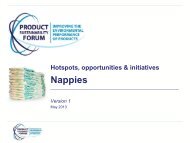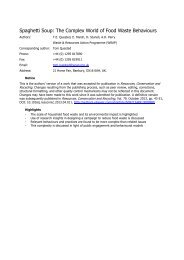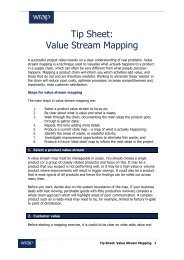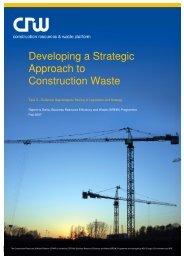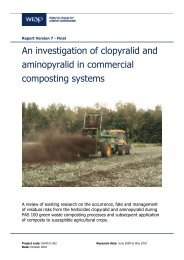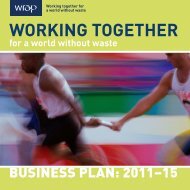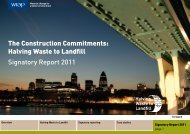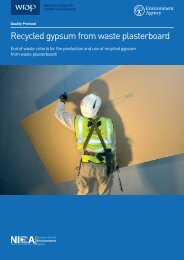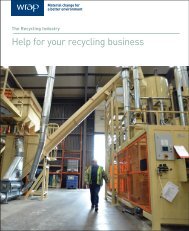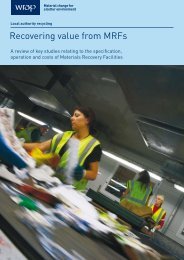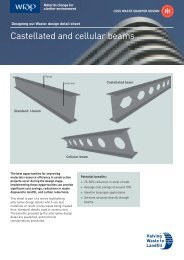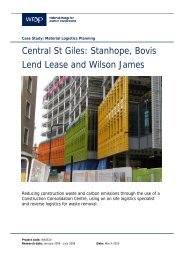Delivering effective Waste Minimisation - Wrap
Delivering effective Waste Minimisation - Wrap
Delivering effective Waste Minimisation - Wrap
Create successful ePaper yourself
Turn your PDF publications into a flip-book with our unique Google optimized e-Paper software.
<strong>Delivering</strong> <strong>effective</strong> <strong>Waste</strong> <strong>Minimisation</strong> 29<br />
Guidance Note 3: Procurement<br />
Overview<br />
Far too often materials are brought to site<br />
only to then be wasted. The principle of<br />
waste minimisation in procurement involves<br />
producing accurate estimates of materials<br />
required and then using these materials<br />
more efficiently.<br />
The quantity of materials ordered is often<br />
inaccurate and unreliable and results in<br />
over ordering and material wastage. This is<br />
an area where costs can be saved through<br />
buying better. There is scope for waste (and<br />
its associated cost) to be accurately estimated,<br />
controlled and reduced during procurement.<br />
This is primarily a subcontract issue as it is<br />
the subcontractors who usually place orders<br />
for materials with suppliers. Subcontractors<br />
should use their expert onsite knowledge to<br />
produce accurate and realistic estimates of<br />
material requirements and their associated<br />
waste. This highlights the importance of early<br />
contractor involvement and communication<br />
streams throughout the supply chain.<br />
Subcontractors play an integral and essential<br />
part in the drive to reduce waste on projects<br />
but they must also be supported by clients<br />
and main contractors.<br />
3.1 Procurement solutions<br />
Subcontractors can follow a procedure<br />
outlined below to improve their materials<br />
ordering process. This process encourages<br />
subcontractors to make robust and realistic<br />
allowances for their waste, gather data on how<br />
much waste they do generate, and then use<br />
this information to improve their waste profile.<br />
Figure 3.1 sets out how subcontractors can<br />
reduce waste by taking action in four stages.<br />
At each stage subcontractors can do<br />
something to reduce the waste they generate.<br />
The stages are:<br />
planning;<br />
implementation;<br />
review; and<br />
improvement.<br />
Within each stage, subcontractors can<br />
monitor material use and wastage rates with<br />
the aid of a series of supporting checklists and<br />
proformas. Areas where the client and main<br />
contractor can support the subcontractor in<br />
doing so are also included.<br />
Communication opportunities<br />
Design opportunities<br />
Procurement opportunities<br />
• Planning<br />
• Implementation<br />
• Review<br />
• Improvement<br />
Logistics opportunities<br />
Project timeline<br />
Case study 3.1<br />
Retail development<br />
A retail development employed a subcontractor to carry out 2D and 3D<br />
modelling using PC software to compare drawings and eliminate clashes<br />
in the different drawings of the architects, engineers, and highways,<br />
building services, structural and sub-structural versions. Many errors<br />
and inconsistencies were found. Although the clash detection exercise<br />
cost £100k to the client and designer, the overall savings were suggested<br />
to be £2.5m<br />
Figure 3.1: Outline of how subcontractors can reduce waste by taking<br />
action to in four stages<br />
Planning<br />
Client sets<br />
targets for waste<br />
Main contractor<br />
prepares<br />
Site <strong>Waste</strong><br />
Management Plan<br />
Subcontractor<br />
estimates waste<br />
Quantitative<br />
estimate 1<br />
1 2 3 4<br />
Qualitative<br />
checklist 1<br />
Implementation<br />
Main contractors<br />
and<br />
subcontractors<br />
review waste<br />
and take action<br />
to minimise<br />
and<br />
manage waste<br />
Quantitative<br />
record 2<br />
Review<br />
Main contractor<br />
requests final<br />
waste information<br />
from<br />
subcontractors<br />
Subcontractors<br />
complete<br />
waste information<br />
questionnaires<br />
Qualitative<br />
checklist 2<br />
Main contractor<br />
coordinates data<br />
and feeds back<br />
to client<br />
Improvement<br />
Share lessons<br />
learned<br />
Promote<br />
innovation<br />
Raise<br />
awareness<br />
Demonstrate<br />
better financial<br />
and<br />
environmental<br />
results



